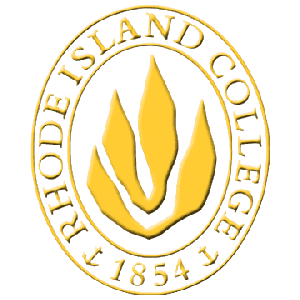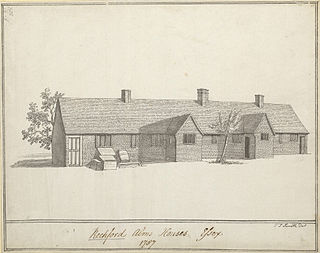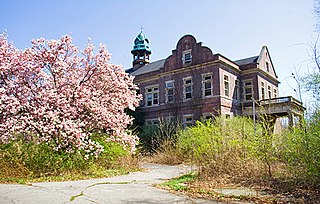
Newport is a seaside city on Aquidneck Island in Rhode Island, United States. It is located in Narragansett Bay, approximately 33 miles (53 km) southeast of Providence, 20 miles (32 km) south of Fall River, Massachusetts, 74 miles (119 km) south of Boston, and 180 miles (290 km) northeast of New York City. It is known as a New England summer resort and is famous for its historic mansions and its rich sailing history. The city has a population of about 25,000 residents.

Rhode Island College (RIC) is a public college in Rhode Island, which much of the land in Providence, and other parts in North Providence. The college was established in 1854 as the Rhode Island State Normal School, making it the second oldest institution of higher education in Rhode Island after Brown University. Located on a 180-acre campus, the college has a student body of 9,000: 7,518 undergraduates and 1,482 graduate students. RIC is a member of the NCAA and has 17 Division III teams.

An almshouse is charitable housing provided to people in a particular community, especially during the Middle Ages. They were often targeted at the poor of a locality, at those from certain forms of previous employment, or their widows, and at elderly people who could no longer pay rent, and are generally maintained by a charity or the trustees of a bequest. Almshouses were originally formed as extensions of the church system and were later adapted by local officials and authorities.
A poorhouse or workhouse is a government-run facility to support and provide housing for the dependent or needy.

Lincoln Carter Almond was an American attorney and politician who served as the 72nd Governor of Rhode Island from 1995 to 2003. A member of the Republican Party, he was previously the United States Attorney for the District of Rhode Island from 1969 to 1978 and again from 1981 until 1993.

Tewksbury Hospital is a National Register of Historic Places-listed site located on an 800+ acre campus in Tewksbury, Massachusetts. The centerpiece of the hospital campus is the 1894 Richard Morris Building.

The Minnesota State Public School for Dependent and Neglected Children was a residential and educational facility for wards of the state from 1886 to 1945, located in Owatonna, Minnesota, United States. The State School was created by an act of the Minnesota legislature in 1885 as an effort to provide safe, transitional housing for the state's orphaned, abandoned, and abused children. The goal was to remove at-risk children from harmful situations and place them in the State School, where they would reside in a home-like setting, receive an education, and eventually be placed with suitable farm families. Over 60 years of operation, the State School was home to a total of 10,635 children.

The California School for the Blind is a public educational institution for blind children, K-12, located in Fremont, California. Its campus is located next to the California School for the Deaf.

Rhode Island Hospital is a private, not-for-profit hospital located in the Upper South Providence neighborhood in Providence, Rhode Island. It is the largest academic medical center in the region, affiliated with Brown University since 1959. As an acute care teaching hospital, Rhode Island Hospital is the principal provider of specialty care in the region and the only Level I Trauma Center in southeastern New England. The hospital provides a full range of diagnostic and therapeutic services to patients, with particular expertise in cardiology, including the state's only open heart surgery program; diabetes, emergency medical and trauma, neurosciences, oncology/radiation oncology, orthopedics, pediatrics, and surgery. Rhode Island Hospital's pediatrics division, Hasbro Children's Hospital, is the only pediatric facility in the state. Recording nearly 154,000 visits in the fiscal year of 2016, Rhode Island Hospital's adult and pediatric emergency wings are among the busiest in the United States.

The Community College of Rhode Island (CCRI) is a public community college in Rhode Island. It is the only community college in the state and the largest community college in New England. The college's primary facility is located in Warwick, with additional college buildings throughout the state.

Pennhurst State School and Hospital, originally known as the Eastern Pennsylvania State Institution for the Feeble-Minded and Epileptic was a state-run institution for mentally and physically disabled individuals of Southeastern Pennsylvania located in Spring City. After 79 years of controversy, it closed on December 9, 1987.

Downtown is the central economic, political, and cultural district of the city of Providence, Rhode Island, United States. It is bounded on the east by Canal Street and the Providence River, to the north by Smith Street, to the west by Interstate 95, and to the south by Henderson Street. The highway serves as a physical barrier between the city's commercial core and neighborhoods of Federal Hill, West End, and Upper South Providence. Most of the downtown is listed on the National Register of Historic Places as the Downtown Providence Historic District.
Child and family services (CFS) is a government or non-profit organisation designed to better the well being of individuals who come from unfortunate situations, environmental or biological. People who seek or are sought after to participate in these homes have no other resource to turn to. Children might come from abusive or neglectful homes, or live in very poor and dangerous communities. There are also agencies that cater to people who have biological deficiencies. Families that are trying to live in stable lives come to non-profit organisations for hope of a better future. Child and family services cater to many different types of people who are all in different situations. These services might be mandated through the courts via a governmental child protection agency or they might be voluntary. Child and family services may be mandated if:

The Minnesota Home School for Girls was a reformatory in Sauk Centre, Minnesota, United States. It was Minnesota's first single-sex reformatory for girls from its establishment in 1911 to 1967, when it switched to a coeducational model and shortened its name to the Minnesota Home School. The facility closed in 1999. The campus was designed on the Cottage Plan, with dispersed buildings in a bucolic setting, by Minnesota state architect Clarence H. Johnston Sr. The site has been converted to a veteran care center called Eagle's Healing Nest.

Deveaux School Historic District is a national historic district located at Niagara Falls in Niagara County, New York.
The Rhode Island Department of Children, Youth & Families (DCYF) is a state agency of Rhode Island, headquartered in Downtown Providence. The agency provides services for children and families.

Letchworth Village was a residential institution located in Rockland County, New York, in the hamlet of Thiells built for the physically and mentally disabled of all ages, from the newborn to the elderly. Opened in 1911, Letchworth Village at its peak consisted of over 130 buildings spread out over many acres of land. It was named for William Pryor Letchworth, who espoused reform in the treatment and care of the insane, epileptics, and poor children.

The Portsmouth Cottage Hospital was the first hospital built in the city of Portsmouth, New Hampshire. Opened in 1884, it was one of the first hospitals in New Hampshire, and it served as the city's primary hospital facility until 1986, when Portsmouth Regional Hospital opened. Its 1895 campus has been repurposed to house city offices and the police station, and a senior living facility. A portion of that facility, representing its oldest buildings, was listed on the National Register of Historic Places in 1996.

Wisconsin Industrial School for Girls was a 19th-century American reform school in Milwaukee, Wisconsin. The Wisconsin Industrial School for Girls was the only secular reformatory institution in the state where delinquent and neglected girls could make a home. The school's purpose was the prevention of crime and pauperism of unfortunate girls; and the restoration of those who had fallen into bad habits, or inherited vicious tendencies. The system of discipline and education was adapted to the condition and needs of the pupils. There were several buildings associated with the school, including the Main Building, Russell Cottage, Lynde Cottage, Cottage Annex, Merrill Model Home, Assembly Hall, Steward's Home, Steam Heating Plant and Barn

The Mount Penang Juvenile Justice Centre is a heritage-listed former juvenile detention centre, now a parkland and redevelopment precinct known as Mount Penang Parklands. It is situated on the Pacific Highway at Somersby, Central Coast, New South Wales, Australia. It was designed by James Nangle and built from 1912 by the New South Wales Public Works Department. It was also known as The Farm Home for Boys, Girrakool and Kariong Juvenile Detention Centre. It was added to the New South Wales State Heritage Register on 19 September 2003. Today, Mount Penang Parklands is a redevelopment precinct containing parks and gardens, a high school, an events park, commercial and office space and residential development.





















